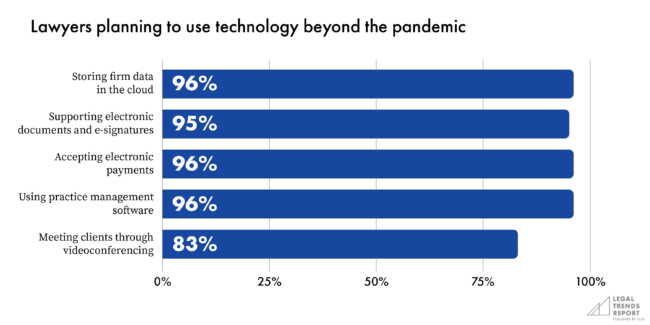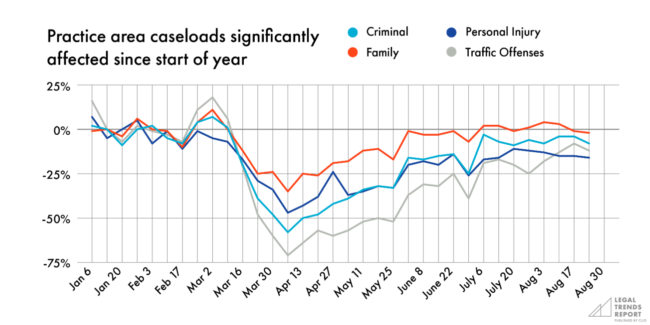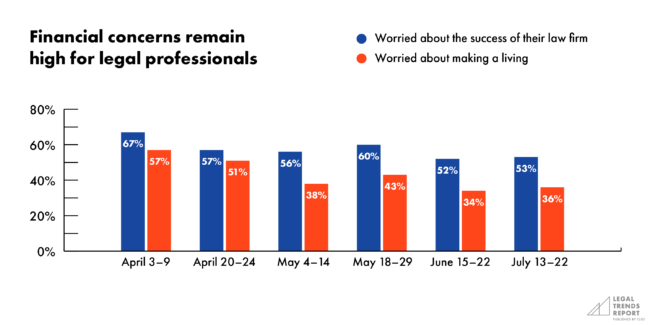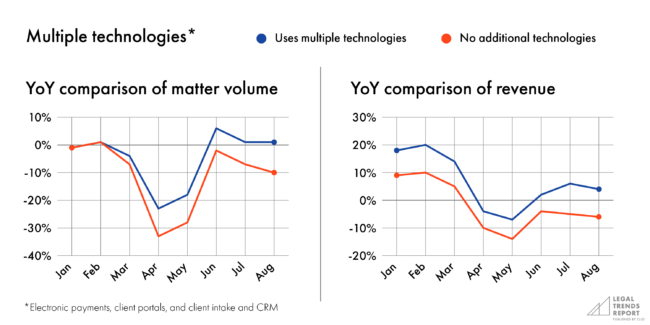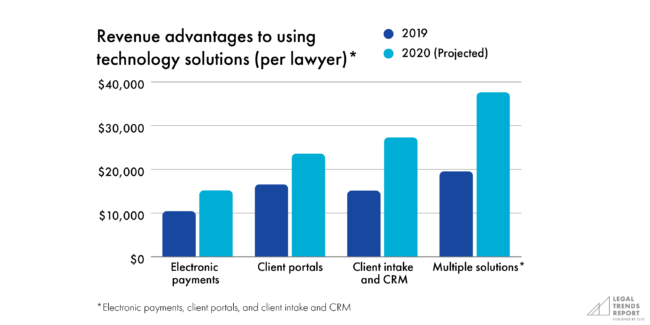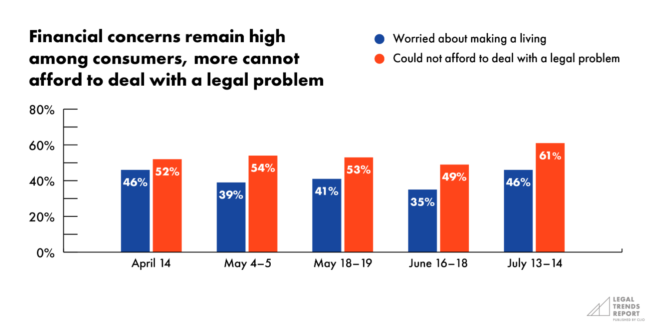During the Clio Cloud Conference today, practice management company Clio today released its annual Legal Trends Report, based on analysis of data from tens of thousands of legal professionals and surveys of legal professionals and legal consumers, and it shows that the coronavirus crisis has resulted in a decided shift in legal practice, away from bricks-and-mortar offices and towards cloud-based technologies and virtual delivery of legal services.
“We’ve seen a seismic shift from lawyers working in physical spaces to working remotely, a trend that many — both lawyers and their clients — will look to maintain even beyond the social impact of the global pandemic,” Clio cofounder and CEO Jack Newton says in the introduction to the report.
“In turn, the technology adoption that we’ve seen during this period has laid the foundation for a new legal-service model that will be better suited to the needs of clients.”
As a result of the pandemic, more lawyers than ever before are using technology to manage their practices, and the majority of those are using various forms of cloud-based technology.
The report finds:
- 85% of law firms are using software to manage their practice.
- 79% of lawyers rely on cloud technology to store their firm’s data.
- 62% of firms allow clients to securely share and sign documents electronically.
- 73% of firms allow clients to pay invoices electronically.
- 83% of firms are meeting with clients virtually.
The need to work remotely has encouraged the online transition that many law firms had been putting off, the report says, and it’s a transition they are not likely to turn back from. The overwhelming majority of lawyers say they plan to use technology beyond the pandemic:
- 96% say they’ll store firm data in the cloud.
- 95% say they’ll support electronic documents and signatures.
- 96% say they’ll accept electronic payments.
- 96% say they’ll use practice management software.
- 83% say they’ll meet clients through videoconferencing.
Lawyers also overwhelming support greater use of technology by court systems, the report finds. At the same time, some lawyers expressed concern about the barriers that technology can create, especially for those in vulnerable populations without the tools or means to access the internet.
For this reason, the report says, the increasing shift to an online-first structure for legal services should include multiple forms of interaction to “help create a more versatile and robust system that’s better suited to the needs of everyone.”
The End of the Office?
While the pandemic forced most lawyers to abandon their bricks-and-mortar offices, at least temporarily, the report finds that both lawyers and clients are questioning whether they should ever go back.
Clio’s surveys of legal professionals and consumers find that neither group considers commercial office space as highly important. In fact, more than half of consumers believe that most legal matters can be handled remotely and roughly a third believe all lawyers should run their practices virtually in the future.
The report finds that, even before the pandemic, 21% of law firms were already operating without commercial office space. Since the pandemic, another 7% of lawyers have given up their commercial offices and 12% are unsure they’ll keep them going forward.
Elimination of offices could mean huge savings for firms in rents and greater flexibility for both firms and clients in how services are provided. But even firms that retain offices will have to continue to provide options for providing services remotely, the report says.
The pandemic presents an opportunity for firms to rethink their physical offices, the report says, in ways that will make the spaces more efficient and more comfortable and that will enable more nimble firm operations.
“In spaces that were once built around large private office spaces for lawyers, there’s an opportunity to prioritize shared meeting rooms that still allow for private communications when needed. Rooms will need to be equipped with videoconferencing screens and not be limited to teleconferencing. There’s also an opportunity to reduce the space needed for physical infrastructure — in-house library stacks, filing, and on-premise server rooms — and to instead rely more on the cloud.”
Whether firms abandon their offices or reimagine them, the bottom line, the report concludes, is that “the future of law firms will be cloud-based by design.”
Pandemic’s Impact on Practices
The report provides a detailed look at the impact the pandemic has had on law practices. By the end of March, it finds, as the pandemic came into full force, law firms began to be hit hard, with significant drops in new cases and revenue.
In April, firms saw a 30% drop in new matters opened over the prior year and collected 8% less revenue. In May, new matters were down 25% compared to 2019 and firms collected 13% less revenue. By June, most firms saw substantial recovery in new matter creation and revenue collection compared to the previous year, but as the virus began to resurge over the summer, firms again saw a dip in new matters.
Certain practice areas were harder hit than others, the report finds. The most significant drops in caseloads were for firms that handle criminal, personal injury, and traffic matters. Practices focused on business matters, such as intellectual property and commercial transactions, were far less affected.
On a per-lawyer basis, this translated to a revenue loss of $1,616 in April and $2,373 in May. It also resulted in staff cuts, with 11% having cut staff in April and 26% in May.
Further, anxiety remains high among the legal professionals. As of mid-July, over half of legal professionals remained worried about the success of their firms and over a third remained worried about making a living.
More Tech = More Success
One of the most interesting sections of this year’s report examined data on the use of certain cloud-based technologies and quantified their impact on firms’ survival and profitability during the pandemic.
The report looks specifically at three types of technology: online payments, client portals, and client-intake and CRM software. Because Clio aggregates and anonymizes data from tens of thousands of its own customers, it is able to see how they use these technologies and the results they delivered.
It compared two groups of firms — those that started using these technologies before 2020 and those that did not. (It specifically looked only at firms using its own products: Clio Payments, Clio Connect and Clio Grow.)
It found that firms that used any one of these technologies saw much better year-over-year business performance throughout the pandemic. They also saw an overall greater volume of casework and per-lawyer revenue throughout 2019 and 2020.
Further, the use of more than one of these technologies appeared to have a compounding effect, both in impact during the pandemic and in overall volume of casework and revenue collection.
The report says that law firms that used all three of these technologies saw a dramatically lessened reduction in casework and revenue loss during the early days of the pandemic. In addition, they saw greater revenue growth before the pandemic and have achieved more positive recovery from June onward.
“The adoption of cloud-based and client-centered technologies can have real impacts on firm performance, and can even greatly reduce the negative impact of COVID-19 on law firms,” the report concludes. “In fact, firms that have adopted these technologies are seeing positive growth, while those that haven’t are still seeing shortfalls.”
Clio CEO Jack Newton attributes this phenomenon to the “aggregation of marginal gains,” a concept developed by Dave Brailsford, coach of British Cycling, based on the idea that many small improvements, even though insignificant in isolation, can compound to create dramatic results.
“The aggregation of marginal gains is a powerful framework that doesn’t just promise results — it opens up many paths to success,” Newton writes in the report’s introduction. “Any one action can create positive results down the road, but many actions can dramatically alter the course and speed toward improvement.
“2020 will be a pivotal year in steering the future direction of legal,” he continues, “of which technology is becoming a central factor of vision and innovation.”
Impact on the Client
The impact of the pandemic on law firms cannot be viewed in isolation from its impact on clients. Even before the pandemic, the report says, the average American could not afford to deal with a legal problem that required hiring a lawyer. In the midst of the pandemic, the percentage of consumers who could not afford a lawyer has grown.
“In 2020, with unemployment rates and job insecurity reaching record levels, the affordability of legal services is an issue that’s only grown increasingly problematic for consumers,” the report says.
The fact that so many legal problems are not pursued indicates larger, more structural issues within the legal profession, the report says. “The average lawyer delivers legal services in a way that is fundamentally outdated when compared to the needs of today’s clients.”
Pricing is only part of the answer to this problem, the report says. “Lawyers should look at expanding their notion of affordability by exploring other tools and structures for packaging their legal services.” These include payment plans and fixed fee billing. Other alternatives include unbundled legal services and subscription-based legal services.
“Innovating new cost and payment structures that enable more consumers to pursue their legal problems will unlock massive market potential,” the report concludes.
 Robert Ambrogi Blog
Robert Ambrogi Blog
